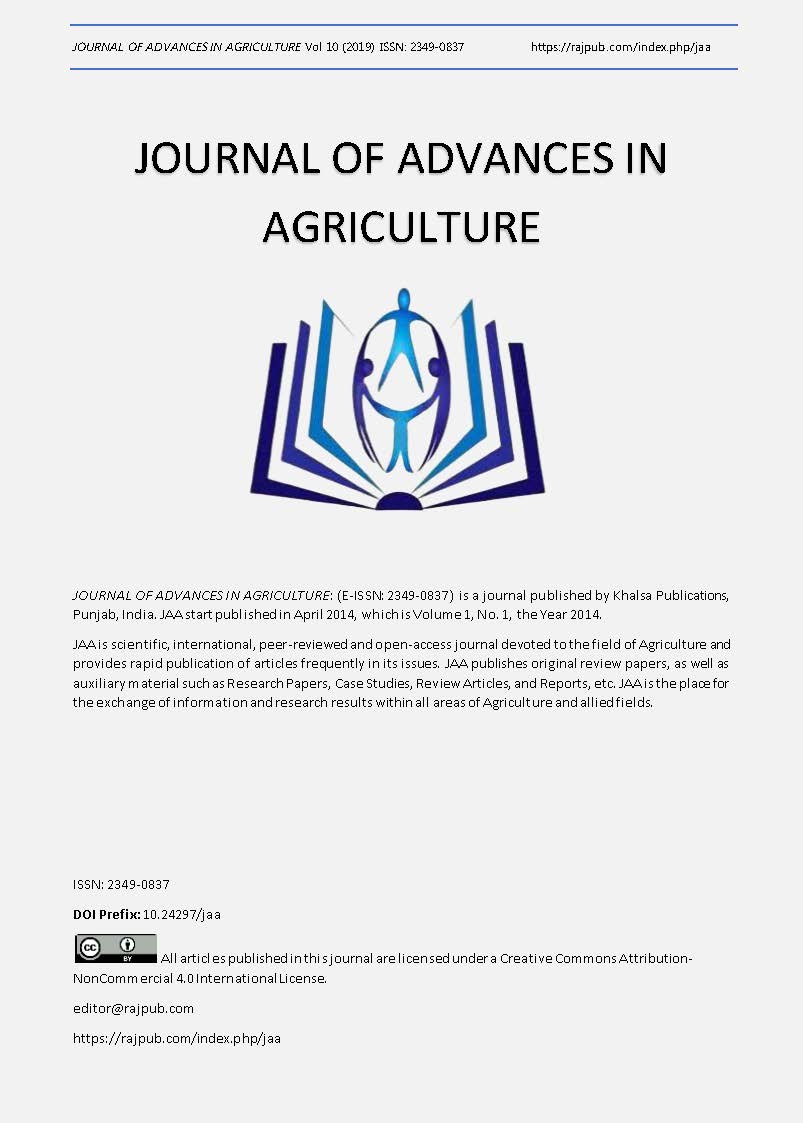Disinfection of Fruits with Activated Water
DOI:
https://doi.org/10.24297/jaa.v10i0.8462Keywords:
Anolyte, Catholyte, Cherries, Sour Cherries, Strawberries, DecontaminationAbstract
The effect of ionized aqueous solutions (anolytes and catholyte) in the processing of fruits (cherries, morellos, and strawberries) for decontamination has been tested. Freshly prepared analytes and catholyte without the addition of salts were used, as well as stored for 7 months anolytes, prepared with 0.5% NaCl and a combination of 0.5% NaCl and 0.5% Na2CO3. The anolyte prepared with a combination of 0.5% NaCl and 0.5% Na2CO3, as well as the anolyte obtained with 0.5% NaCl, exhibit high antimicrobial activity against the surface microflora of strawberries, cherries, and sour cherries.
They inactivate E. coli for 15 minutes. The other species of the fam. Enterobacteriaceae were also affected to the maximum extent, as is the total number of microorganisms, especially in cherries and sour cherries. Even stored for 7 months, they largely retain their antimicrobial properties. Anolyte and catholyte, obtained without the addition of salts, showed a lower effect on the total number of microorganisms, but had a significant effect on Gram-negative bacteria, and especially with regard to the sanitary indicative E. coli.
Downloads
References
Abadias, M. J. Usall, M. Oliveira, I. Alegre, I. Viñas. Efficacy of neutral electrolyzed water (NEW) for reducing microbial contamination on minimally-processed vegetables. Int J Food Microbiol., 31, 123 (1-2), :151-158, 2008. doi: 10.1016/j.ijfoodmicro.2007.12.008.
Adhikari, A., K. Kharel, K. Fontenot. Wash Water Chlorine Disinfection: Best Practices to Ensure On-Farm Food Safety. The LSU AgCenter and the LSU College of Agriculture. 6/21/2019. https://www.lsuagcenter.com/articles/page1561146897345. P3448_WashWaterBestPracticesREVada_RH0519_AAdhikaripdf thumbnail
Beuchat, L. R. Pathogenic microorganisms associated with fresh produce. J. Food Prot., 59, 204-216, 1996.
Beuchat, L. R. Surface decontamination of fruits and vegetables eaten raw: a review. World Health Organization (WHO/FSF/FOS/98.2), 1998.
European Commission. Risk Profile on the Microbiological Contamination of Fruits and Vegetables Eaten Raw. Report of the Scientific Committee on Food. Health & Consumer Protection Directorate-General Directorate C - Scientific Opinions C2 - Management of scientific committees II; Scientific co-operation and networks. Scientific Committee on Food SCF/CS/FMH/SURF/Final, 29 April 2002.
Feliziani, E., A. Lichter, J. L. Smilanick, A. Ippolito. Disinfecting agents for controlling fruit and vegetable diseases after harvest. Postharvest Biology and Technology, 122, 53-69, 2016.
Gluhchev, G., D. Mehandjiev, I. Ignatov, S. Karadzhov,Y. Pesheva, A. Atanasov. Water electrolysis - processes in catholyte and anolyte results with differential non – equilibrium water spectrum. European Journal of Medicine, 6, 1, 3 – 12, 2018. ISSN: 2310-3434. DOI: 10.13187/ejm.2018.1.3.
Ignatov, I., G. Gluhchev, S. Karadzhov, G. Miloshev, N. Ivanov, O. Mosin. Preparation of Electrochemically Activated Water Solutions (Catholyte/Anolyte) and Studying Their Physical-Chemical Properties. Journal of Medicine, Physiology and Biophysics, 11, 1-21, 2015. www.iiste.org, ISSN 2422-8427 (Online).
Ivanov, Y. Types of chemical compounds that can be used for disinfection of vegetables intended for direct consumption, ways of use, permissible levels of residues after a subsequent washing with drinking water from the point of view of the safety of the offered final product.Bulgarian Agency of Food Safety, Center for Risk Assessment, Standpoint No 0147-0687 of 31.08.2016.
Oie, S., H. Kiyonaga, Y. Matsuzaka, K. Maeda, Y. Masuda, K. Tasaka, S. Aritomi, A. Yamashita, A. Kamiya. Microbial contamination of fruit and vegetables and their disinfection. Biol Pharm Bull., 31, 10, 1902-1905, 2008. PMID:18827352, DOI:10.1248/bpb.31.1902
Korany, A. M., Z. Hua, T. Green, I. Hanrahan, S. H. El-Shinawy, A. El-Kholy, G. Hassan, M. J. Zhu. Efficacy of Ozonated Water, Chlorine, Chlorine Dioxide, Quaternary Ammonium Compounds, and Peroxyacetic Acid Against Listeria monocytogenes Biofilm on Polystyrene Surfaces. Front Microbiol., 12, 9, 2296, 2018. doi: 10.3389/fmicb.2018.02296. eCollection 2018. PMID:30369909, PMCID:PMC6194171, DOI:10.3389/fmicb.2018.02296
Popova, T. P., T. E. Petrova. Disinfection of leafy vegetables with activated waters. Journal of Advances in Agriculture, 9, 1534-1545, 2018, ISSN: 2349-0837.
Popova, T. P., T. Petrova, and S. Karadzhov. Investigation of the biocidal effect of electrochemically activated aqueous sodium shloride solution on Gram-negative pathogenic bacteria. Int..J. Curr. Microbiol. App. Sci., 5, 1, 624-632, 2016 a. (DOI: http://dx.doi.org/10.20546/ijcmas.2016.501.063
Popova, T. P., T. Petrova, and S. Karadzhov. Investigation of the Action of the Anolyte after Different Storage Times on the Gram-negative Bacteria. Int.J.Curr.Microbiol.App.Sci., 5, 9, 530-539, 2016 b. doi: http://dx.doi.org/10.20546/ijcmas.2016.509.059.
Popova, T. P., T. Petrova, S. Karadzhov, and G. Krustanova. Investigation of the biocidal effect of electrochemically activated aqueous sodium chloride solution on Staphylococcus aureus. Traditions and modernity in veterinary medicine, Scientific Journal of the Faculty of Veterinary Medicine of University of Forestry, Sofia, 1, 1, 67-72, 2016 c. ISSN 2534-9333, e- ISSN 2534-9341.
Rabin, J. “Pack tomatoes for higher profits - chlorinating packing shed wash water improves quality.” American Vegetable Grower, 34, 8, 12, 1986.
Samadi, N., N. Abadian, D. Bakhtiari, M. R. Fazeli, H. Jamalifar. Efficacy of detergents and fresh produce disinfectants against microorganisms associated with mixed raw vegetables. J Food Prot., 72, 7, 1486-1490, 2009. PMID:19681275. DOI:10.4315/0362-028x-72.7.1486
Sapers, G.M. Efficacy of Washing and Sanitizing Methods for Disinfection of Fresh Fruit and Vegetable Products. Food Technology and Biotechnology, 39, 4, 305-311, 2001.
Tasheva, Y., Y. Petkov, S. Karadzhov. Test of the action of electrochemically activated aqueous solutions (anolytes) on Candida albicans. Proceedings of the FVM, UF, Sofia "Traditions and contemporaneity in Veterinary Medicine", pp. 152-158, 2010.
Wei, W., X. Wang, Z. Xie, W. Wang, J. Xu, Y. Liu, H. Gao, Y. Zhou. Evaluation of Sanitizing Methods for Reducing Microbial Contamination on Fresh Strawberry, Cherry Tomato, and Red Bayberry. Front Microbiol., 8, 2397, 2017. Published online 2017 Dec 5. doi: 10.3389/fmicb.2017.02397.
Zoellner, C., A. Aguayo-Acosta, M. W. Siddiqui, J. Dávila-Aviña. Peracetic Acid in Disinfection of Fruits and Vegetables. In: Postharvest Disinfection of Fruits and Vegetables. Chapter: 2. Publisher: Academic Press, Elsevier. August 2018. DOI: 10.1016/B978-0-12-812698-1.00002-9.
Downloads
Published
How to Cite
Issue
Section
License
 All articles published in Journal of Advances in Linguistics are licensed under a Creative Commons Attribution 4.0 International License.
All articles published in Journal of Advances in Linguistics are licensed under a Creative Commons Attribution 4.0 International License.




